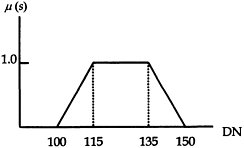74.
| [Cover] [Contents] [Index] |
Page 164
function to perform fuzzy partitioning. The input s is the temperature measure (°C) and the temperature range is divided into hot (from 50° to 100°C), warm (from 30° to 70°C), and cold (from 0° to 40°C) fuzzy subspaces. According to this fuzzy partition, water temperatures between 50° and 70°C simultaneously hold hot and warm fuzzy membership (the membership grade varies according to the membership functions). Water temperatures between 30° and 40°C are members of the warm and cold categories. Such fuzzy boundaries are more flexible in coping with real world problems.
Once the construction of fuzzy subspaces is accomplished, a fuzzy rule is then set up for each subspace. As we know, a normal crisp rule given to 1—dimension input space has the following simple linguistic form IF s is A THEN Z in which the ‘if’ clause is known as a condition, the ‘then’ clause is known as consequent, s denotes a measurement, A describes the decision boundaries, and Z denotes the result or action. For example, in case of image classification, the rule could become:
IF the pixel value is between 100 and 150
THEN the pixel is assigned to the class ‘Potato’.
Once a crisp rule is triggered, it results in a unique decision. The fuzzy rule concept softens the crisp rule description, so that the above crisp rule becomes:
IF pixel value is middle
THEN the pixel is assigned to the class ‘Potato’ with strength w.
The term ‘middle’ is modelled by a fuzzy membership function, and the strength w is determined by how well the pixel value belongs to middle. For instance, if we use a trapezoidal membership function to model middle as shown in Figure 4.9, then pixel values between 115 to 135 will trigger the rule at full strength giving a membership grade of 1. Pixel value in the

Figure 4.9 A trapezoidal membership function to model the concept ‘middle’. See text for description.
| [Cover] [Contents] [Index] |
EAN: 2147483647
Pages: 354